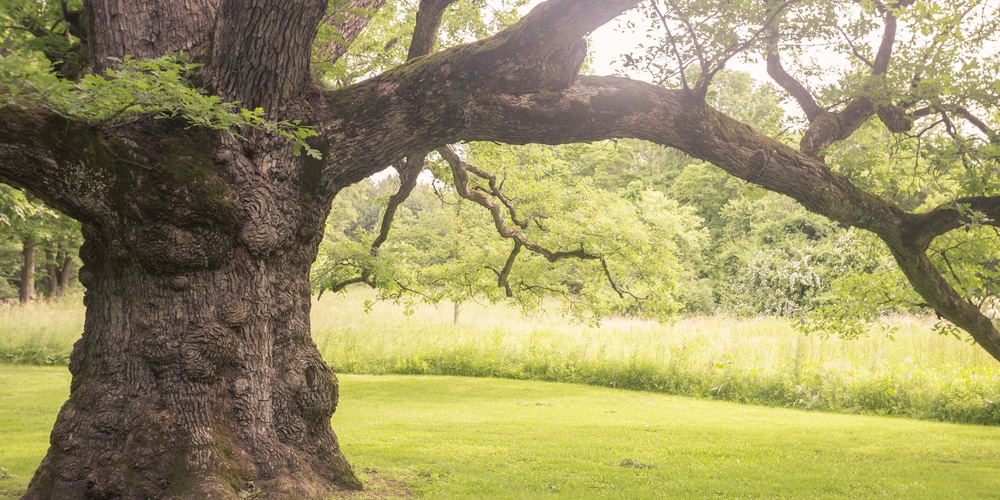Most kids love playing on swings, and many would like nothing more than to have their own swing in the family’s yard. If you want to create a swing but don’t have a tree available with good-sized branches or a branch in the correct position, you may be able to suspend a swing between two trees.
Two trees that are growing close enough together will be able to support a hanging swing. Let’s look at how to hang a swing between two trees, including tree selection, swing location, and what to consider before hanging your swing.
1. Select Safe Trees

The first thing you’ll need to do is consider how sturdy the trees in your yard are, as safety should be a top priority. It would help if you aimed to build a swing that’s durable and long-lasting. To do this, you’ll need to use good quality components and choose strong and well-established trees.
It’s best to suspend a tree between two broad hardwood trees such as oak, maple, or sycamore. Avoid using smaller trees that are more delicate, like willow, ash, or birch. You should also carefully check the trees to ensure they are healthy and don’t have any visible issues such as cracks, loose branches, or decaying spots that may indicate the tree is dying.
You may also like to see professional advice from a tree surgeon, who will be able to check the health of your trees and advise about suspending a swing from its branches. The trees need to healthy enough to cope with the bolts that support the swing set and should be able to continue growing around any hard wear used.
You’ll also need to consider the distance between the two trees before deciding which type of swing to install and the materials to use.
When you hang a swing between two branches, make sure that the branches are not facing down. If they do face down, there’s a very strong chance that they will slide towards each other and that the swing will fail. You wan branches that are between the three o’clock and two o’clock angle.
2. Swing Selection
You’ll then need to select the type of swing your child would like and ensure that it can be fitted to your trees. A variety of different swings are available, from traditional wooden swings to plastic-coated slings, large saucers that can hold more than one child, or disk swings suspended by one rope.
A traditional swing can be hung between two trees using a cross beam or pole that will span the gap between the two trees. Alternatively, swings are available that use ratchet straps which are tied down and connected via swivels to carabiners that suspend the swing.
The type of swing you choose will determine what type of suspension system you can use. Before making decisions about the kind of swing and how to suspend it, you should think about which would suit your children and yard.
3. Suspending a Swing Between Two Trees
When building a swing, you’ll need to ensure you use high-quality materials to support your children’s weight. If you’re choosing a larger swing that supports more than one child, you’ll need to ensure you use good quality ropes and suspension set.
You can either build the swing yourself from scratch or buy a set from Amazon, which can be hung between your trees.
Materials
To build a swing between two trees, you’ll need a piece of 4 by six wood or a metal pole with a diameter of six inches to span the gap between the trees. You’ll also need a durable rope made from either polyester, braided nylon, or manilla, from which you’ll hang the swing.
Ideally, the rope should be at least ¾ inches in diameter and have a length of about twenty feet. To work out exactly how much rope you need, you can calculate the height of the swing, times this number by two, and add twelve feet.
You’ll also need to find something to use as the swing seat if you’re not using a ready-made swing set. You may choose a tire, a piece of a chair, or a smooth flat piece of wood.
Measurements
Ensure that the swing isn’t hanging too close to the trunk of the tree. It’s a good idea to leave at least three feet of space between the tree trunk and the swing. This will ensure your children don’t knock against the trunk as they swing or get their fingers trapped against the tree.
Your swing should be hung about three feet off the ground, depending on the age and height of your children.
Landing zone
It’s also a good idea to clear a landing zone around your swing. This may involve removing foliage and plants as well as rocks and twigs. Ensure that there’s a soft landing by allowing thick, dense grass to grow around the swing. Never lay concrete or paving slabs around a swing.
Hanging A Swing from A Tree Without Branches
If you want to hang a swing between two trees without using the branches, you can attach a crossbeam to the two tree trunks. Make sure that the crossbeam is connected securely using either treehouse attaching bolts (TABs) or lag screws. Poles can also be tied to the tree trunk securely using manilla rope.
Another excellent way to securely hang a swing between two trees is to ratchet tie-down straps between the trees. This will require the tension to be correct so that the swing can be suspended from swivels that are clipped to carabiners. If you’re using beams or poles, you’ll need to attach the swing to eye bolts that you’ve fitted through the pole.
Conclusion: Hang a Swing Between Two Trees
Kids love playing on swings, just like in the good old days. Many people build swings in their backyard, and these are often hung between two trees.
Swinging for a tree can be very relaxing whatever your age and is also fun and entertaining. However, it’s crucial to ensure your swing is built from good quality materials and is correctly fitted to ensure it doesn’t break or snap and injure your children.
A good swing should be durable and long-lasting, comfortable to use, and user-friendly.

